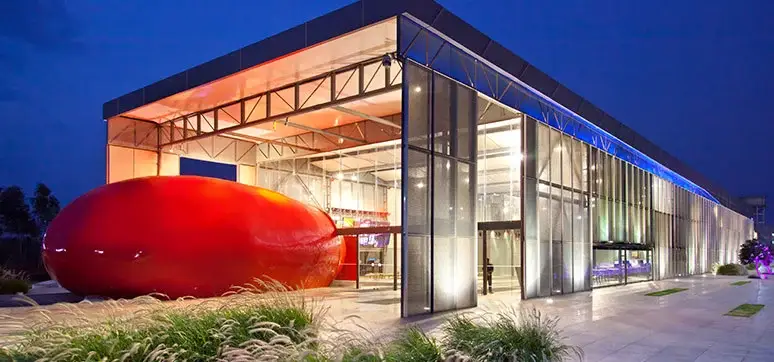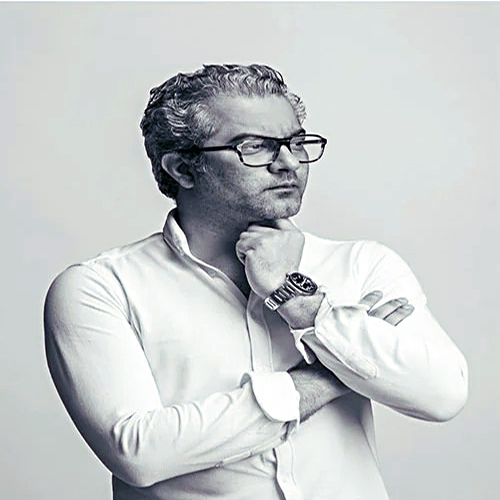Please tell us about your practice and its growth over the years.
Our practice, Architecture Discipline, is based in New Delhi and our expertise spans many multidisciplinary fields from residential and retail interiors to large-scale public and commercial projects.
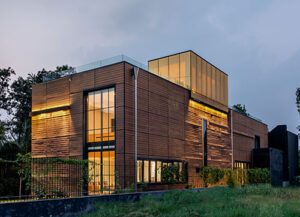
Our projects are spread across the length and breadth of India and we attribute this growth to our thorough design processes, from full-scale mock-ups to long-term material investigations, which strive to develop programmatic and technical flexibility.
When we started in 2007, our goal was to stay true to this process and we have indeed followed through, continuing to reinvent ourselves for now and the years to come. The firm’s work has been critically acclaimed in India: multiple Indian Institute of Interior Designers (IIID) Awards, an NDTV DAA Architect of the Year Award (2013); citations from Alliance Francaise (2012), Architectural Digest India (2015), the National Gallery of Modern Art (2015); a felicitation by the Government of India (2015), the ID Honours award (2020) and the AD100 award for the 100 most influential Architects and Interior Designers in India (2020).
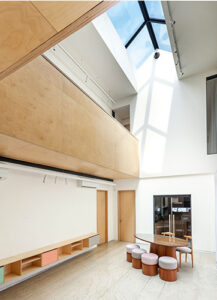
What inspired you to become an architect?
I was thirteen years old when I saw an architect’s drawing board for the first time. I was fascinated by everything on it and not in a deep philosophical sense — at that age, it was a contraption that could move in all directions, with tools, tackles, and really cool coloured stationery. But, in my second year of architecture school, I saw a rooftop extension in the library by the design studio Coop Himmelb(l) au, which made me realise that architecture can be bold, edgy, and progressive and that there is more to it than block-work and organic settlements.
Before I studied architecture formally, I was already studying music and it gave me an insight into how to use a universal language to create a regional or personalized expression. What any subject or formal education does is that it allows you to post-rationalize and strategize things that go beyond your intuition. Of course, your first reactions and the strongest ones are always intuitive but formal education allows you to rationalize it and build upon it further and definitely, helps you to get out of sticky situations.
So, if you study the rules of the competition and the tools and devices available to you while doing something including the value system, it allows you to find answers very quickly without a hit-and-trial approach which essentially reduces waste, in terms of time and material.

Could you please talk about a few of your ongoing projects?
We are developing a series of modular primary clinics for the Government of Delhi, built of repurposed shipping containers. The Mohalla Clinic is a fully furnished, prefabricated unit that can be easily installed with minimal construction in dense urban regions. We are also currently working on the following residential projects: i. A house in Vagator, Goa made out of mass timber ii. A modular prefabricated concrete farmhouse with a timber brise soleil in Delhi iii. A residence for American Diplomats at West End, Delhi iv. Adaptive re-use of a 15,000-sq. ft Art Deco villa at Jor Bagh, Delhi.

There are many façade materials available in the market. How do you choose the apt one for your project? What are the criteria?
As a practice, our approach is grounded in longevity — we design open-ended, adaptable frameworks with large, well-serviced, and well-lit floors – spaces that can be used for multiple activities in the short term and offer the possibility for a long lifespan along with a variety of long term uses. The same values extend to our material choices, with a high emphasis placed on reusability and modularity.
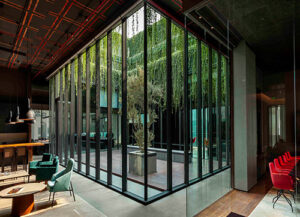
Each project presents its specific needs in terms of material selection, however, the basic properties that we look for in our selection process are durability, health and safety, and ease of maintenance of products.
Façade materials should have high thermal performance and the material economy should suit our client’s requirements. Primarily, the design dictates the choice of material and we make efforts towards finding materials that do not compromise on the carbon footprint of the project and ensure post-occupancy safety for the inhabitants. Anything that manifests physically needs to have distinct materiality associated with it. The choice of materials determines what direction you want to pursue in your architectural dialogue. While there are materials that lend a heavy look and feel, some are used to reinforce a design’s architectural expression, and others are more ephemeral. Some elements ask a question more than they make a statement.
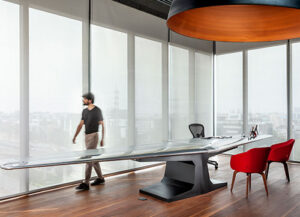
Tell us about a few of your milestone projects.
Our notable projects include Mana Hotel in Ranakpur; the Discovery Centre, a town hall and sales office for the Bhartiya City township in Bangalore; and the India Pavilion at Hannover Messe (Hanover) in 2015, which was adjudged the ‘Best Pavilion’ in the 65-year history of the Messe. Notable ongoing work includes refurbishment projects for The Oberoi Group’s properties in Agra and Kolkata, a modular primary clinic for the Government of Delhi, and an urban regeneration project in the walled city of Jodhpur, India. The refurbishment of the Oberoi Grand in Kolkata is probably the most challenging project that we have undertaken.
It’s one of the oldest buildings in the country and a Grade-1 restricted heritage building. Because of the tremendous amount of architectural history, you can touch very little. There are also many layers of emotional and narrative history that the building has imbibed. So, working within the physical limitations of a structure and expression that you can’t really interfere with, and respecting and recreating the old construction techniques and material history in an existing and operational hotel has been quite a challenge.
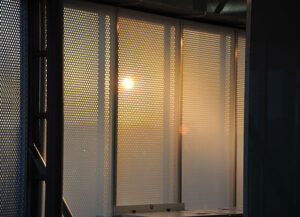
Façade designs/ materials and technologies have gone through a sea change in the past decade. Tell us about the latest in use of materials for façade and as cladding material.
As we are a practice that focuses on keeping up with changing times and delves into thorough research before embarking on
projects, we seek to reinvent the use of materials in our projects. For example, at Palm Avenue, a residence in New Delhi, we used elongated horizontal wooden planks as cladding to articulate simple lines for the exterior built form. The project also maximized daylight flowing into the large double-height living space through generously sized windows on three sides of the home and a large skylight on the roof. We take utmost care to use materials that not only satisfy the design’s needs but also ensure that the project will continue to be in use for decades to come.
At the corporate headquarters for the Rug Republic, the façade material is used to make a strong statement about the building’s surroundings. Its exposed corten steel shell finds justification in the site’s industrial skyline and protects the building’s interiors from its hostile and acrid environment. A material that acquires a patina with time and ages well, it lends a new identity to the pre-existing building, making it relevant for many years to come. An environmentally conscious material palette lends a regional yet contemporary flavour to the Mana Hotel in Ranakpur, Rajasthan. The façade features random rubble masonry, an archetypal local material juxtaposed with structural steel trusses. Glazed roof sections and perforated ceiling panels maintain visual connections to the sky and imbue the building with a sense of lightness and porosity.
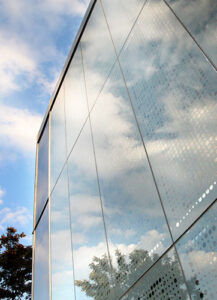
53 Silver Oaks, a residence in
Gurugram
What is your view on efficient glazing technologies and those used in your projects?
We consciously strive to maximize efficiency in every element of our projects, and the same goes for glazing technologies. For example, the East India Hotels Corporate Headquarters in Gurugram has an external glass façade allowing a panoramic view of its urban context, while an internal glass courtyard provides relief and transparency across the floor plate. This project received a LEED Platinum certification. High-performance glass and heat-reflective blinds have been used to modulate and control heat gain, minimizing heated pockets within smaller spaces. In the chairman’s office, smart automation controls allow users to control the roller blinds, optimizing energy efficiency.
The selection of the glass and processing considers a 25-year life span. The intelligent design approach and choice of efficient glazing material together led to a successful project. In other projects, perforated patterns are printed on glazing panels to filter sunlight and reduce heat gain. Frit-printed glass has been used at the Discovery Centre in Bengaluru and the 53 Silver Oaks residence in Gurugram to allow for the dissipation of heat and create dappled light patterns in interior spaces. During the nighttime, light filters out of the building through these perforations, creating a subtly lit spectacle for onlookers.
What are the key factors to consider while designing and installing glass façades & fenestration?
An unrestricted, desirable view must be framed. The design and installation of glass façades should always be dependent on the project’s contextual natural light availability. We consider the direction of sunlight and the building’s orientation as key factors to design fenestrations that maximize natural light without heat gain. The use of high-performance glass which essentially consists of vacuum-sealed double-glazed panels helps reduce heat gain in the building — decreasing the dependency on air conditioning while bringing in an ample amount of daylight to minimize the need for artificial lighting.
Fritted and patterned glazing also dissipates heat gain, while creating a sense of transparency and lightness. Privacy must also be taken into consideration when designing fenestrations, along with other performance criteria like safety, lifespan, and serviceability.
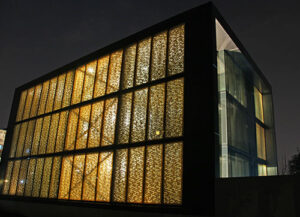
Please brief on the design and technical details of a safe glass façade, considering fire safety, and wind, rain, and earthquake resistance.
The glass must be appropriately treated to be fire-safe. The processes and applications for this change over time; therefore, it is important to keep abreast of the most recent developments in the field. Refer to manuals but also speak to industry experts regularly. At Architecture Discipline, we encourage CPD (Continuing Professional Development) workshops so that everyone is updated on the best products available. Safety and stability in a seismic event or against lateral loads such as high wind speeds and typhoons must be considered in the design of a safe glass façade. An appropriate system should be engineered for the right tolerances, especially for tall structures.
How would the façade design and other elements of the façade help the building to be energy-efficient, and at the same time provide a better interior environment? What about sustainability and environmental considerations when choosing the façade/cladding material?
Façade and cladding are meant to protect a building from moisture, wind, and heat and are an integral part of the building envelope, responsible in many ways for a building’s overall thermal performance. The material choice should not merely be driven by aesthetic considerations but also serve as a shield from extreme weather, especially seen in Indian climatic conditions. These materials should serve their purpose of protecting the building from heat gain, allowing the ingress of natural light, and generating a low carbon footprint, while being functional and permitting the building to breathe.
Cladding materials with high thermal performance can be used as thermal mass, to decrease the heat transferred into the building’s interior spaces. Material palettes should comprise locally available options as much as possible, with a focus on low-embodied energy alternatives. Façades must also incorporate materials with longer life spans and the potential for reuse – modular façade elements allow for easy replacement and repurposing.
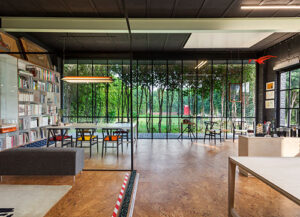
What are your views on future façades & fenestration technologies, and materials?
Fundamentally, the sustainable design tenets we follow in our projects are: minimising consumption, maximizing efficiency, reducing waste, and generating energy. These tenets are also reflected in our façade and fenestration material choices, and we believe that this will be a prominent trend in the future, part of a larger move towards sustainability in the built environment. Research, development, and technology should focus on creating cutting-edge sustainable solutions for façades and fenestrations, with drastic reductions in negative environmental impacts.
I like working with neutral materials that don’t colour the inside, robotic architectural muscles, and thermocouples. The computational design allows us to resolve complex skin conditions in a relatively easy manner; therefore, it’s important to utilize technology to ensure that the façade is well-integrated and not a mere imposition.

According to you, what is an intelligent façade? How can intelligent façades bring in the greenhouse effect and also restrict the intensive use of air conditioners?
The external environment is dynamic, whether it is concerning decibel levels, air quality, direct solar ingress, or the changing quality of the skyline. Dynamic or adaptive skins allow us to animate the built form and mitigate the heat. They also use thermocouples, photovoltaics, and wind turbines allowing captive power generation. These are exciting times when architecture must undo the damage that overpopulation has caused. These intelligent façades can revolutionize the future of buildings by maximizing daylight and reducing heat gain which restricts the use of artificial lighting and reduces dependence on air conditioners.
What is your advice to young, aspiring architects?
I think education in design is more about grooming people with an attitude and character. It is incorrect to believe that only architects need to work in a collaborative environment. Even for an artist or a poet, there are many collaborative processes involved, from putting paint on a canvas to delivering the end product to a client.
However, one thing that remains true to both art and architecture is that while nothing can replace the connection between your hand and your brain when you’re sketching, a lot can be substituted by virtual processes. While site visits are an essential component of the architectural curriculum, they are not a compulsion anymore. There was a time when architects would walk around, draw plans for a scheme and then search for a site. But now, more often than not, a site is zoned and allocated to an architect beforehand.
Furthermore, in the age of the drone and the high-resolution camera, it is possible to minimize the need for a site visit. The best way for students to maximize their time and not miss out on opportunities is by learning the essential skills: reading, writing, and sketching. Find a good studio to work with and hone your skills. Building physics is a much-ignored subject in our country and one that needs the most attention, so stay in one place and learn in-depth from the studio you’re working with.
